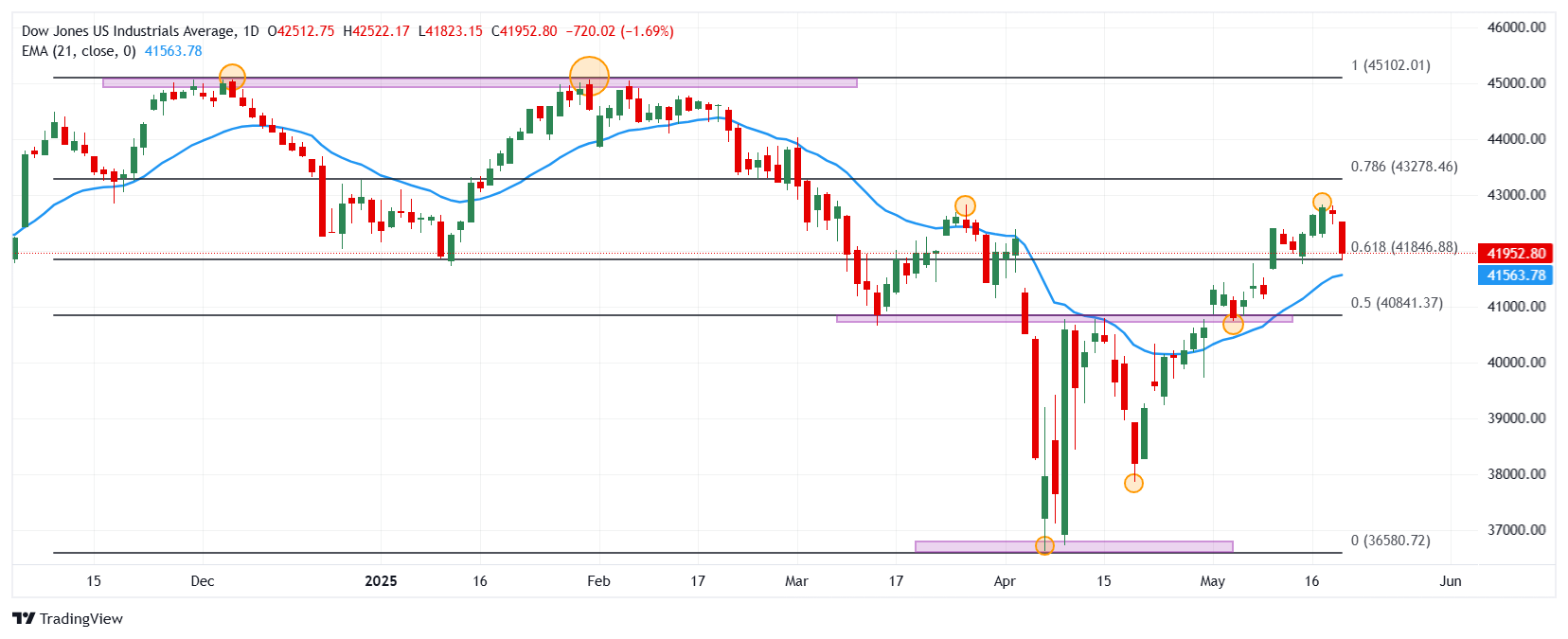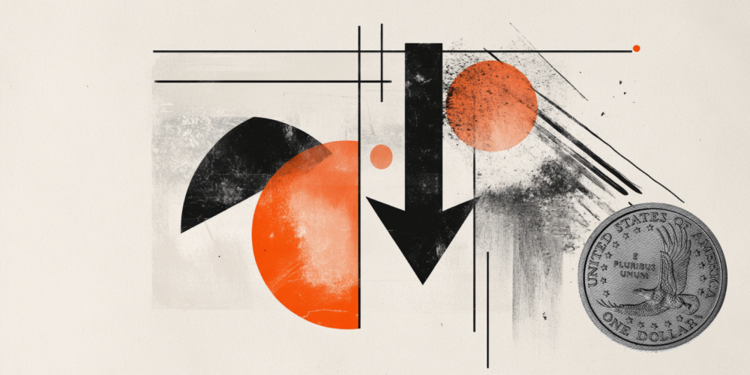- The Dow Jones falls 1.52% today, operating currently 42,012.
- The Nasdaq 100 loses 0.82% in the day, dragged by Palo Alto Networks (PANW).
- The S&P 500 goes back 1.13% on Wednesday, weighed by Fair Isaac Corporation (FICO).
- The US economic agenda contemplates the services, manufacturing and integrated, to be published tomorrow.
The Dow Jones marked a maximum of the day in 42,522, finding aggressive vendors that took the index to May 15 in 41,823.
The Dow Jones industrial average opened at 42,512, while the Nasdaq 100 technological index began operating at 21,400. The S&P 500 began negotiations in 5,930, extending the losses of yesterday.
The Dow Jones reaches minimum one week weighed by UnitedHealth
The Dow Jones index slides 1.52% daily, reaching a minimum not seen since May 15 in 41,823.
The actions of UnitedHealth (UNH) fall 5.45% daily, visiting minimum of two days at $ 300.07, ending with three consecutive upward days, leading losses in the stock market index.
In the same tonic, Nike (NKE) values record a loss of 3.45% today, approaching May 9 at 60.25 $.
In this scenario, the Dow Jones went back 640 points in the day, quoting the moment of writing about 42,012, signing its second consecutive day down.
Palo Alto Networks leads losses in Nasdaq 100
The Nasdaq 100 technological index falls 0.82% in the day, reaching minimum of two days in 21,091.
The shares of Palo Alto Networks (PANW) collapse 6 20% reaching minimums not seen since April 28 at $ 178.64, concluding a streak of four consecutive days with profits.
In the same tune, the Microstrategy Incorporated (MSTR) values lose 4.73%, visiting May 19 minimums in 396.52 $.
The Nasdaq 100 slides 191 points today, consolidating in minimum of two days in 21,179, in tune with the main stock market indices.
The S&P 500 falls to a minimum of one week dragged by Fair Issac Corporation
The company specialized in credit analysis, Fair Isaac Corporation (FICO), records a drop of 13.98%, reaching minimum of April 8 in $ 1,658, spinning two consecutive sessions downward.
The collapse of Fico’s actions is presented after making known an increase in commissions when evaluating credit scores. In this sense, Bull Abute, director of the Federal Housing Financing Agency of the United States, said that FICO should make sure to be as economical as possible, criticizing the recent increase in its commissions.
The S&P 500 goes back 1.13%, visiting minimums of May 15 in 5,849, extending the losses presented yesterday.
Technical Analysis of Dow Jones
The Dow Jones reacted down from a short -term resistance given by the maximum of May 19 in 42,832. The next key resistance is 45,068, a pivot point of January 31. To the south, the closest support is located in 40,747, minimum of May 6, in convergence with the 50% fibonacci setback.
Dow Jones daily graphics

Dow Jones Faqs
The Dow Jones Industrial Avenge, one of the oldest stock market indexes in the world, consists of the 30 most negotiated values in the United States. The index is weighted by the price instead of capitalization. It is calculated by adding the prices of the values that compose it and dividing them by a factor, currently 0.152. The index was founded by Charles Dow, also founder of the Wall Street Journal. In recent years it has been criticized for not being sufficiently representative, since it only follows 30 companies, unlike broader rates such as S&P 500.
There are many factors that promote the Dow Jones Industrial Average (DJIA) index. The main one is the added performance of the companies that compose it, revealed in the quarterly reports of business benefits. The American and world macroeconomic data also contribute, since they influence investor confidence. The level of interest rates, set by the Federal Reserve (FED), also influences the DJia, since it affects the cost of credit, on which many companies depend largely. Therefore, inflation can be a determining factor, as well as other parameters that influence the decisions of the Federal Reserve.
Dow’s theory is a method to identify the main trend of the stock market developed by Charles Dow. A key step is to compare the direction of the Dow Jones Industrial Avenge (DJIA) and the Dow Jones Transportation Average (DJTA) and just follow the trends in which both move in the same direction. The volume is a confirmation criterion. The theory uses elements of maximum and minimum analysis. Dow’s theory raises three phases of the trend: accumulation, when intelligent money begins to buy or sell; Public participation, when the general public joins the trend; and distribution, when intelligent money abandons the trend.
There are several ways to operate with the DJ. One of them is to use ETF that allow investors to negotiate the DJ as a single value, instead of having to buy shares of the 30 companies that compose it. An outstanding example is the SPDR Dow Jones Industrial Avenge ETF (day). Future contracts on the DJ allow the specular operators about the future value of the index and the options provide the right, but not the obligation, to buy or sell the index at a predetermined price in the future. Investment funds allow investors to buy a part of a diversified portfolio of DJ values, which provides exposure to global index.
Source: Fx Street
I am Joshua Winder, a senior-level journalist and editor at World Stock Market. I specialize in covering news related to the stock market and economic trends. With more than 8 years of experience in this field, I have become an expert in financial reporting.







